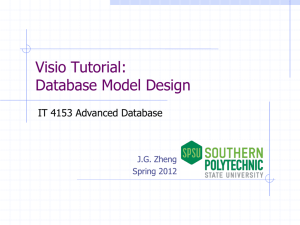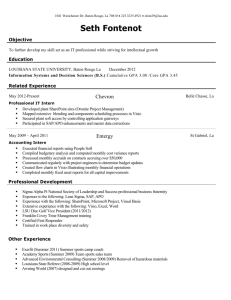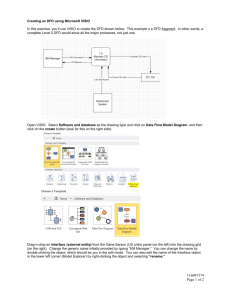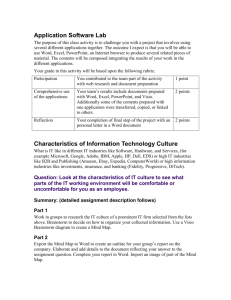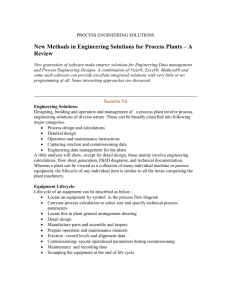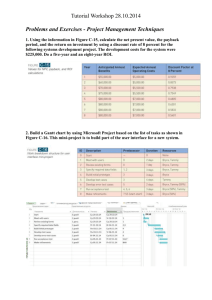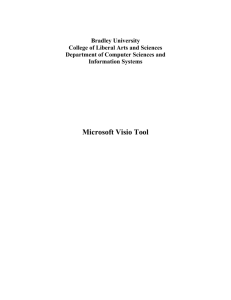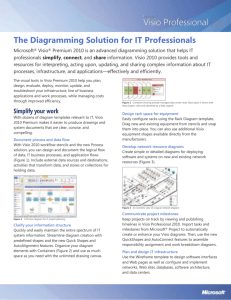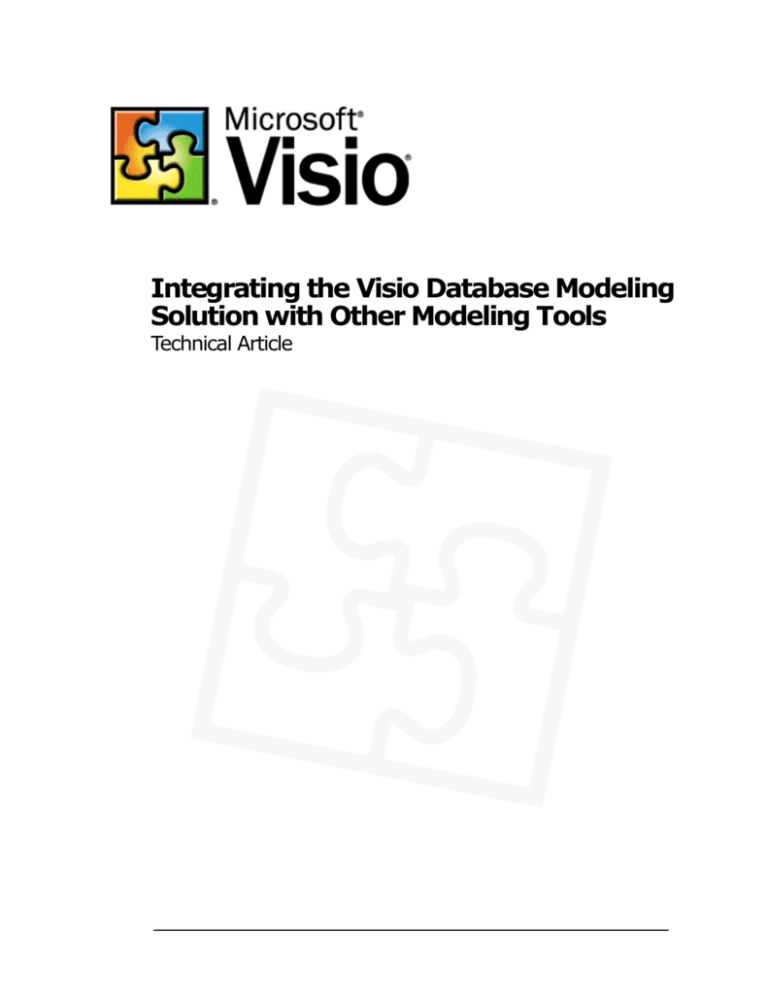
Integrating the Visio Database Modeling
Solution with Other Modeling Tools
Technical Article
Table of Contents
About this article ............................................................................................................. 3
Introduction ................................................................................................................... 3
How to Share Model Data Between Visio and Other Database Modeling Tools ......................... 7
Visio 2000 Database Solution ........................................................................................... 8
Import Computer Associates ERwin .ERX file ................................................................... 8
Export Computer Associates ERwin .ERX file ................................................................... 8
Import VisioModeler (formerly InfoModeler) files ............................................................. 9
Import Visio 5.0 Professional ER or Crow’s Foot diagrams ............................................... 10
Import Visio 5.0 Enterprise Database Model Diagrams ................................................... 10
Share Models via the Microsoft Repository using the Database Information Model ............. 11
Share Models Via Creation and Reverse Engineering from Common DBMS ........................ 13
Visio Professional 2002 Database Solution........................................................................ 15
Import Computer Associates ERwin .ERX File ................................................................ 15
Import VisioModeler (formerly InfoModeler) Files .......................................................... 16
Import Visio 5.0 Enterprise, Visio 2000 Enterprise and Professional Database Model Diagrams
............................................................................................................................... 17
Share Models via Creation and Reverse Engineer from Common DBMS (Reverse Engineer
only for Professional) ................................................................................................. 17
Integrating the Visio Database Modeling Solution with Other Modeling Tools
2
Integrating the Visio Database Modeling
Solution with Other Modeling Tools
Technical Article
Visimation, Inc.
Microsoft Certified Partner
Published: September 2001
Applies to:
Microsoft Visio Professional 2002
Microsoft Visio Professional 2000
Microsoft Visio Enterprise 2000
Summary: This document presents the integration possibilities through sharing model data
between Visio and other tools.
For the latest information, please see http://www.microsoft.com/office/visio
About this article
Microsoft® Visio® Professional 2002, Visio Professional 2000, and Visio Enterprise
2000 include a robust database modeling solution. Integration of the database
modeling solution in Visio with other database modeling tools may be helpful in
leveraging existing tools and practices within your organization or aid in migration to
the Microsoft Visio modeling tools. This document presents the integration possibilities
through sharing model data between Visio and other tools such as Computer
Associates Erwin, VisioModeler (formerly InfoModeler), Visio 5.0 Enterprise Database
Solution, Visio 5.0 Professional Database Diagrams, and to any number of tools via
the Microsoft Repository using the open Microsoft Database Model Type Information
Model (DBM TIM) or a commonly supported Database Management System (DBMS).
Introduction
The Database Solution found in Microsoft Visio 2000 Professional and Enterprise
Editions as well as Microsoft Visio 2002 has the ability to integrate with other
modeling tools. For Visio 2000, integration of the Database Solution comes in the form
of transferring model data by import into Visio, export from Visio, or sharing model
data in the Microsoft Repository or another commonly supported database
management system (DBMS). The Microsoft Visio 2002 Database Solution includes
similar sharing opportunities to Visio 2000 with the exception of the Microsoft
Repository support.
The features available for integration with other tools vary primarily by product.
Although Enterprise and Professional versions of Visio 2000 have the same code base
for the Database Modeling solution, the feature set enabled and the installed files
vary. Visio Professional carries a subset of the features and supporting files of the
Integrating the Visio Database Modeling Solution with Other Modeling Tools
3
Enterprise edition. If you are working with Visio 2000, you have more opportunity for
sharing model data using Enterprise than Professional.
The options on the Import menu (Import/Export in Enterprise) for the Database
Solution are covered in this paper. The Visio 2000 Professional and Enterprise versions
of this menu are shown in Figure 1. Some of the options are more of a migration path
rather than for long-term integration. Since these options allow for leveraging of
existing resources, they are also discussed in this paper.
Figure 1. Visio 2000 import and export menu comparison
We will also look at several powerful integration opportunities not shown in the
Import/Export menu. These are not technically importing or exporting, but rather a
type of integration via sharing the model through independent tool interaction on a
shared data source. We will cover sharing models via the Microsoft Repository using
the Database Information Model, and via creation and reverse engineering from
common DBMSs.
Microsoft Visio 2000 Enterprise Edition integration opportunities:
Import/Export Erwin .ERX files
Import VisioModeler (formerly Infomodeler) .IMD, .IML, and .IMO files
Import Visio 5.0 Professional ER or Crow’s Foot diagrams
Import Visio 5.0 Enterprise Database Model diagrams
Share models via the Microsoft Repository using the Database
Information Model
Share models via creation and reverse engineering from common DBMS
Microsoft Visio 2000 Professional Edition integration opportunities:
Import Erwin .ERX files
Import VisioModeler (formerly Infomodeler) .IMD files
Reverse engineer schema from common DBMS after creation by another
tool
Microsoft Visio 2002 Professional model sharing opportunities:
Import Erwin .ERX files
Import VisioModeler (formerly Infomodeler) .IMD files
Integrating the Visio Database Modeling Solution with Other Modeling Tools
4
Import Visio 5.0 Enterprise, Visio 2000 Enterprise and Professional
Database Model diagrams
Reverse engineer schema from common DBMS after creation by another
tool
Microsoft Visio 2002 Professional closely follows the same feature set split as Visio
2000 for the Database Modeling solution. The “Enterprise” level features will not be
offered directly under a Visio Enterprise version of 2002, but rather from Visual Studio
Enterprise Architect Edition.
Visio Professional is for customers who:
Need to automatically diagram existing database schema
Need to automatically create UML diagrams from existing Visual Studio
projects
Need to create software and database models via drag & drop
Need to create application infrastructure diagrams using software and
network shapes
Need interoperability for those who need to view or edit models created in
VS.net but don’t need full modeling functionality
Visual Studio.net is for customers who:
Need full-fledged database and software modeling functionality
Forward engineer changes to your database schema
Generate code skeletons from UML class diagrams
Database and UML reporting
Semantic error checking
Business rules-based database design
Need to easily exchange database schema and software models with
other Visio users
Integrating the Visio Database Modeling Solution with Other Modeling Tools
5
Visio 2002
Professional
Edition
Import Erwin .ERX files
Import VisioModeler
(formerly
Infomodeler) .IMD
files
Import Visio 5.0
Professional ER or
Crow's Foot
diagrams
Import Visio 5.0 Enterprise
Database Model
diagrams
Reverse engineer schema
from common
DBMS after
creation by
another tool
Import Erwin .ERX files
Import VisioModeler
(formerly
Infomodeler) .IMD
files
Import Visio 5.0 Enterprise,
Visio 2000
Enterprise and
Professional
Database Model
diagrams
Reverse engineer schema
from common
DBMS after
creation by
another tool
Import/Export Erwin .ERX
files
Import VisioModeler
(formerly
Infomodeler) .IMD,
.IML, and .IMO
files
Import Visio 5.0
Professional ER or
Crow's Foot
diagrams
Import Visio 5.0 Enterprise
Database Model
diagrams
Share models via the
Microsoft
Repository using
the Database
Information Model
Share models via creation
and reverse
engineer from
common DBMS
Import/Export Erwin .ERX
files
Import VisioModeler
(formerly
Infomodeler) .IMD,
.IML, and .IMO
files
Import Visio 5.0 Enterprise,
Visio 2000
Enterprise and
Professional
Database Model
diagrams
Share models via creation
and reverse
engineer from
common DBMS
Additional MS Product Offerings
Visio 2000
Enterprise Edition
Figure 2 compares the Visio database solution integration opportunities by Visio
product and version.
Figure 2. Microsoft Visio database solution integration opportunities by product and version
Integrating the Visio Database Modeling Solution with Other Modeling Tools
6
How to Share Model Data Between Visio and Other
Database Modeling Tools
The remainder of this article takes you through the steps to perform each of the
integration opportunities mentioned in the introduction. This article’s organization is
based on the diagram shown in Figure 2. To find a specific section for a combination of
product and version, go to the version section and then find the activity you want to
do (for example, Import ERWin ERX files). You may also navigate to the section from
the links below:
Version: Visio 2000
Professional Edition
Import Computer Associates ERwin .ERX file
Import VisioModeler Files (formerly InfoModeler)
Import Visio 5.0 Professional ER or Crow’s Foot diagrams
Import Visio 5.0 Enterprise Database Model diagrams
Share models via creation and reverse engineering from common DBMS
(reverse engineer only for Professional)
Enterprise Edition
Import Computer Associates ERwin .ERX file
Export Computer Associates ERwin .ERX file
Import VisioModeler Files (formerly InfoModeler)
Import Visio 5.0 Professional ER or Crow’s Foot diagrams
Import Visio 5.0 Enterprise Database Model diagrams
Share models via the Microsoft Repository using the Database Information
Model
Share models via creation and reverse engineering from common DBMS
Version: Visio 2002
Professional Edition
Import Computer Associates ERwin .ERX file
Import VisioModeler Files (formerly InfoModeler)
Import Visio 5.0 Enterprise, Visio 2000 Enterprise and Professional Database
Model diagrams
Share models via creation and reverse engineering from common DBMS
(reverse engineer only for Professional)
Integrating the Visio Database Modeling Solution with Other Modeling Tools
7
Visio 2000 Database Solution
Import Computer Associates ERwin .ERX file
Both Visio Professional 2000 and Visio Enterprise 2000 include the ability to import
ERwin .ERX files. The versions supported for import include 2.6, 3.0, and 3.52.
The import brings in ERwin model elements including entities, attributes,
relationships, categories, and text blocks. Data types may be converted to either
portable data types for the specific DBMS defined in the .ERX file or to a default data
type. For the conversion of data types to the portable data types for the DBMS, Visio
must have an equivalent Visio Driver for the specific DBMS.
Importing an .ERX file does not bring in certain ERwin features. For example, ERwin
displays, stored procedures, and custom trigger code are not imported.
To perform the import
1. Open a new Visio Database Model Diagram or ER Source Model (Enterprise
Only).
2. Select Import (Import/Export in Enterprise) from the Database menu.
3. On the Import menu, select Import ERwin ERX model.
4. Browse to the file by clicking on the Browse button or enter a full name and path
directly into the form.
5. Click OK to perform the import.
Figure 3. Importing ERwin .ERX files into Visio 2000 Professional or Enterprise
6. After the import is complete, the tables brought in are shown in the Tables
anchored window. Drag and drop the tables you want in your diagram onto the
page.
Export Computer Associates ERwin .ERX file
Besides importing ERwin files, with Enterprise 2000 you may also export to the ERwin
.ERX file format. The versions supported for export include 2.6, 3.0, and 3.5.
To perform the .ERX export
1. Open the Visio Database Model Diagram or ER Source Model that you wish to
export.
2. Select Import/Export from the Database menu.
Integrating the Visio Database Modeling Solution with Other Modeling Tools
8
3. On the Import/Export menu, select Export ERwin ERX model.
4. Choose a file name for the .ERX file.
5. Select the version of .ERX file you wish to create.
6. Click OK to perform the export.
Figure 4. Exporting from Visio 2000 Enterprise to ERwin .ERX format
7. The results of the export are presented in the Output anchored window on the
Import/Export tab. Issues discovered on export are noted; along with what
action the Visio Database Solution did with regard to the issue.
Figure 5. Visio 2000 Enterprise export to ERX format results
Import VisioModeler (formerly InfoModeler) files
The import of VisioModeler files is a migration path enabling previous users of
InfoModeler and VisioModeler to leverage their existing models and move them
forward into the Visio Database Solution. The Visio Database Solution was developed
from the robust InfoModeler technology. There are three types of files that may be
imported into Visio 2000 Enterprise including .IMD, .IML, and .IMO files.
Each of the three file types must be imported into different diagrams in Visio 2000
that correspond to the kind of information in the VisioModeler file: .IMD files are
imported into a Database Model Diagram, .IML files import into an ER Source
Model, and .IMO files may be imported into an ORM Source Model. Since Visio 2000
Professional does not include ER Source Model or ORM Source Model diagrams,
only .IMD files may be imported into Visio 2000 Professional.
Integrating the Visio Database Modeling Solution with Other Modeling Tools
9
Import supports the following versions of VisioModeler (Infomodeler) files: 1.5, 2.0,
3.0 or later
To perform the import
1. Open a new Visio Database Model Diagram, ER Source Model, or ORM Source
Model depending on the type of VisioModeler file you wish to import.
2. Select Import (Import/Export in Enterprise) from the Database menu.
3. On the Import menu, select one of the following, as appropriate:
Import VisioModeler IMD model
Import VisioModeler IML model
Import VisioModeler IMO model
4. Browse to the file by clicking on the Browse button or enter a full name and path
directly into the form.
5. Click OK to perform the import.
Import Visio 5.0 Professional ER or Crow’s Foot diagrams
Visio Professional 5.0 contains a database solution for creating ER and Crow’s Foot
diagrams. Moving these diagrams into the full-featured Database Modeling solution in
Visio 2000 allows users to leverage and expand upon work created in Visio
Professional 5.0. This import is available both in Visio 2000 Professional and
Enterprise.
To perform the import
1. Open a new Visio Database Model Diagram or ER Source Model.
2. Select Import (Import/Export in Enterprise) from the Database menu.
3. On the Import menu, select Import Visio Database Diagram.
4. Browse to the file by clicking on the Browse button or enter a full name and path
directly into the form.
5. Click OK to perform the import.
Import Visio 5.0 Enterprise Database Model Diagrams
Database Model diagrams created in Visio Enterprise 5.0 may be opened in both
Microsoft Visio 2000 Professional and Enterprise editions. A version 5.0 file is
automatically converted to the 2000 format when the file is opened in Visio 2000. To
save in the 2000 format, be sure to save the file. In addition to the file format itself
being converted, Database Model diagrams may need to have shapes migrated to
newer versions of the shapes. This also can be done automatically when the file is
opened. If there are shapes that need to be migrated, you are presented with a dialog
asking whether you wish to create a backup copy of the diagram before migration.
When the migration is complete, a log of the file changes can be viewed.
Integrating the Visio Database Modeling Solution with Other Modeling Tools
10
Share Models via the Microsoft Repository using the Database
Information Model
Visio Enterprise 2000 includes the ability to reverse engineer from and generate to the
Microsoft Repository using the Microsoft Database Model Type Information Model
(DBM TIM). This allows for the use of this open standard for the exchange of model
information that is independent of the physical database implementation. This method
of exchange is likely to give better results for ongoing integration opportunities where
each tool operates independently on the common repository with the schema
information.
Using the Microsoft Repository may be an excellent option for integrating with other
tools if:
The other modeling tools support the Microsoft Repository and Microsoft
Database Model Type Information Model (DBM TIM) for both forward and
reverse engineering.
There is no specific import/export route into the Visio Database Solution
from the tools.
There is an ongoing integration where both tools are used to operate on
the same model data through time.
Note Of the Microsoft Visio products discussed in this paper, the only product that
supports the Microsoft Repository functionality is Microsoft Visio 2000 Enterprise
Edition. No edition of Microsoft Visio 2002 supports the Microsoft Repository for the
Database Solution.
The operations used with this integration are reverse engineering from, and forward
engineering to, the Microsoft Repository. The current schema is maintained within the
Microsoft Repository. Each tool reverse engineers the schema from the Repository
then updates the schema in the Repository after making changes to the model data.
Microsoft Repository
Microsoft Database
Model Type
Information Model
(DBM TIM)
Visio Database
Solution
Other database
modeling tool
Reverse Engineer Schema
Generate / Update Schema
Figure 6. Sharing models using the Microsoft Repository
Integrating the Visio Database Modeling Solution with Other Modeling Tools
11
The initial model data may be placed into the Microsoft Repository from Visio or
another modeling tool. In Visio, use the Generate Wizard, from the Database menu,
for the initial population of the repository. During the initial population, the Generate
Wizard allows for the creation of a blank Jet-based repository and adding of the
Microsoft Database Model Type Information Model (DBM TIM).
After the initial population of the schema in the Microsoft Repository, updates of the
schema from the Visio Database Solution are handled through the Update Database
Wizard. Selecting Update from the Database menu launches the Update Database
Wizard. The Visio drawing may also have the model refreshed against the current
state of the schema by using the Refresh Model Wizard. Selecting Refresh from the
Model sub-menu on the Database menu opens the Refresh Model Wizard.
The Visio Database Solution includes three-way compare technology that allows for
checking the current model in a drawing against an image of the model state when
the database was last updated from the drawing as well as the current schema in the
database. The differences are shown and you are presented with the ability to resolve
the conflicts when using the Model Refresh or the Update Database Wizard. If you
know that resolving the conflict requires a change to the database, you should use the
Update Database Wizard, which can update the model or the database.
Note The scope used in the three-way compare is limited to those tables reverse
engineered from the database or present in the model during an update of the
database. For example, if a table is added to the schema by another tool, the
three-way compare does not indicate the added table as a conflict to resolve. This
design enables you to focus on small parts of a database without being confronted
with unnecessary clutter from changes in the database not directly relevant to your
area of concern. Although this is a benefit for large projects where multiple people
manage different parts of the schema, it may lead to confusion when managing the
schema from multiple tools. It is recommended that a new reverse engineer be
performed to include new schema elements into your Visio Database Model.
Reverse engineering from the Microsoft Repository with Visio Enterprise assumes that
a repository file exists and there is a schema already stored in the repository. Forward
engineering allows creation of a repository file as well as the addition of the Microsoft
Database Model Type Information Model (DBM TIM) and schema. Instructions for
interacting between the Visio Database Solution and the Microsoft Repository are
included below.
To reverse engineer from the Microsoft Repository using the Reverse
Engineer Wizard
1. Open a new Microsoft Visio Database Model Diagram, ER Source Model or
ORM Source Model.
2. Launch the Reverse Engineer Wizard by choosing Reverse Engineer from the
Database menu.
3. Choose Microsoft DBM Repository from the Installed Visio Drivers drop-down
list then click Next.
4. Connect to the Microsoft Repository either by selecting the file, or DSN options
and logon credentials. Then click OK.
5. Select the particular schema to extract from the repository then click OK.
6. Choose the object types to reverse engineer then click Next.
Integrating the Visio Database Modeling Solution with Other Modeling Tools
12
7. The following screens allow sub-selection of the object types reverse engineered
such as the tables and views and stored procedures. Click Next on each screen
after making your selections until reaching the summary screen.
8. On the Reverse Engineer Wizard summary screen, click Finish.
9. The tables and views can be dropped onto the drawing from the Tables Window
if working in the Database Model Diagram or ER Source Model. Facts maybe
dropped out onto the page if working in an ORM Source Model.
Using the Database Update Wizard
1. Open your Database Model Diagram containing the model data to update the
schema.
2. Launch the Database Update Wizard by selecting Update from the Database
menu.
3. Ensure that the option Update the database is selected.
4. Select the option Detect changes in the database if you wish to invoke threeway compare, and then click Next.
5. Choose Microsoft DBM Repository from the Installed Visio Drivers drop-down
list, and then click Next.
6. Connect to the Microsoft Repository either by selecting the file or DSN options and
logon credentials, and then click OK.
7. View the list of conflicts and determine which ones to change in the database,
which to change in the model, and those you do not wish to have changed. Each
conflict can be clicked on and the action to take determined by the radio buttons in
the Resolution frame. Once the conflicts are marked for resolution, click the Next
button.
8. The following two screens provide summary information as to what will change in
the model (the Database Model Diagram), and what will be changed in the
database. Click Next on each screen if the information is correct.
9. The wizard then performs a physical validation of the changes to ensure that there
are no errors. Click Next to continue if physical validation is complete without
errors.
10. The wizard then performs the changes and presents you with the option of viewing
the DDL if you specified in the wizard to generate DDL.
Share Models Via Creation and Reverse Engineering from Common
DBMS
Visio Professional supports reverse engineering but not forward engineering. For Visio
Professional, you can go from another tool into a commonly supported DBMS and then
into Visio Professional. This may offer a good migration path from other tools and
existing models into Visio Professional.
Visio Enterprise 2000 includes the ability to reverse engineer from and generate to
many DBMSs.
Working with multiple applications in an on-going integration situation (many trips to
and from each application for the same model) is best handled going through a
Integrating the Visio Database Modeling Solution with Other Modeling Tools
13
common middle ground, a defined standard, preferably one in which each application
has as part of it’s core competency. For the Visio Database Solution, and probably for
many relational database modeling tools, this core competency is reverse and/or
forward engineering to a data source for some specific DBMSs. Find the commonly
supported DBMSs and you have likely candidates for sharing the model.
Once you find a commonly supported DBMS, you can generate a test or exchange the
database that you use for the shared schema. To find which DBMSs are supported for
the Visio Database Solution, open a new Database Model Diagram and select
Drivers from the Options sub-menu on the Database Menu. The list of Installed
Visio Drivers shows the DBMSs supported. Two generic drivers are listed: the ODBC
Generic Driver and the Generic OLE DB Provider. The remaining drivers in the list are
specific to a DBMS and will give better results than the generic drivers.
Figure 7. Visio 2000 Supported DBMSs
Note Select the intermediate DBMS with care. It is important to ensure that the
features you are concerned with are handled by the DBMS. For example, if you
were concerned with triggers and stored procedures, then Microsoft Access would
not be the best choice of an intermediate DBMS because Access does not support
triggers and stored procedures.
Logically, this sharing is similar to the option discussed in the section Share models
via the Microsoft Repository using the Database Information Model. The
difference is really what DBMS you are using for the storing the schema.
Integrating the Visio Database Modeling Solution with Other Modeling Tools
14
Commonly
supported DBMS
Visio Database
Solution
Other database
modeling tool
Reverse Engineer Schema
Generate / Update Schema
Figure 8. Sharing models using a commonly supported DBMS
Similar to sharing models in the Microsoft Repository, the actions performed from
each tool involve reverse engineering from the DBMS and forward generation
(updates) from the tool back to the DBMS. The current schema is maintained in the
DBMS. From within Visio Enterprise, the wizards used to accomplish these tasks are
the Generate Wizard (for initial population of the schema if it is coming from Visio),
the Update Database Wizard, and the Reverse Engineer Wizard.
Visio Professional 2002 Database Solution
Import Computer Associates ERwin .ERX File
Like Visio 2000 Professional, Microsoft Visio 2002 Professional includes the ability to
import ERwin .ERX files. The versions supported for import include 2.6, 3.0, and 3.52.
The import brings in ERwin model elements including entities, attributes,
relationships, categories and also text blocks. Data types may be converted to either
portable data types for the specific DBMS defined in the .ERX file or to a default data
type. For the conversion of data types to the portable data types for the DBMS, Visio
must have an equivalent Visio Driver for the specific DBMS.
Importing an .ERX file does not bring in certain ERwin features. ERwin displays, stored
procedures, and custom trigger code are not imported.
To perform the import
1. Open a new Visio Database Model Diagram or ER Source Model (Enterprise
Only).
2. Select Import from the Database menu.
3. On the Import menu, select Import ERwin ERX model.
Integrating the Visio Database Modeling Solution with Other Modeling Tools
15
4. Browse to the file by clicking on the Browse button or enter a full name and path
directly into the form.
5. Click the OK button to perform the import.
Figure 9. Importing ERwin .ERX files into Visio 2002 Professional
After the import is complete, the tables brought in will be shown in the Tables
and Views window. Drag and drop the tables you want in your diagram onto the
page.
Import VisioModeler (formerly InfoModeler) Files
The import of VisioModeler files provides a migration path enabling previous users of
InfoModeler and VisioModeler to leverage their existing models and move them
forward into the Visio Database Solution. The current Visio Database Solution was
developed from the robust InfoModeler technology.
There are three types of VisioModeler files including .IMD, .IML, and .IMO files. Based
on the type of information in the files and the corresponding file types in Visio 2002
Professional, only .IMD files may be imported. The other VisioModeler files correspond
to ER Source Models and ORM Source Models that are found in Visio 2000 Enterprise
Edition and can be imported into a 2002 version using additional Database Modeling
functionality to be packaged with other Microsoft product offerings such as Visual
Studio.
Import supports the following versions of VisioModeler (Infomodeler) files: 1.5, 2.0,
3.0 or later.
To perform the import
1. Open a new Microsoft Visio Database Model Diagram.
2. Select Import from the Database menu.
3. On the Import menu, select Import VisioModeler IMD model.
4. Browse to the file by clicking on the browse button or enter a full name and path
directly into the form.
5. Click the OK button to perform the import.
Integrating the Visio Database Modeling Solution with Other Modeling Tools
16
Figure 10. Importing VisioModeler .IMD files into Visio 2002 Professional
Import Visio 5.0 Enterprise, Visio 2000 Enterprise and Professional
Database Model Diagrams
Database Model diagrams created in Visio Enterprise 5.0, Microsoft Visio 2000
Professional and Enterprise editions may be opened in Visio 2002 Professional. You
may be prompted regarding enabling macros for Microsoft Visual Basic for Applications
(VBA). Since the VBA project associated with a Database Model Diagram should be
empty, it is not necessary to enable the macros.
When a database drawing from a previous version of the Visio Database Solution is
opened, the shapes in the drawing need to be updated to a later version. You are
prompted when older shapes are found and asked whether you wish to save a backup
copy of the file as well as create a report of all changes made during the update.
Share Models via Creation and Reverse Engineer from Common
DBMS (Reverse Engineer only for Professional)
Like Visio 200 Professional, Visio 2002 Professional includes reverse engineering
capabilities but does not include forward engineering capabilities. Given this, it is
possible to use the reverse engineering capability as a powerful migration tool for
moving existing models from other tools into Visio 2002 Professional. The key to this
migration is finding a commonly supported DBMS. Once one is identified, the model
data can be forward engineered into the intermediate DBMS from another modeling
tool and then reverse engineered into Visio 2002 Professional.
Note ‘Enterprise’ level functionality such as forward engineering capabilities are to
be available with other Microsoft Product offerings such as Visual Studio.
To find the Visio 2002 supported DBMSs, open a new Database Model Diagram and
select Drivers from the Options sub-menu on the Database Menu. The list under
Default driver for Visio gives the DBMSs supported. Two generic drivers listed are
the ODBC Generic Driver and the Generic OLE DB Provider. The remaining drivers
in the list are DBMS specific and provide better results than the generic drivers.
Integrating the Visio Database Modeling Solution with Other Modeling Tools
17
Figure 11. Visio 2000 Supported DBMSs
About Visimation
Visimation is a Microsoft Certified Partner who specializes in Microsoft Visio consulting,
custom development, training, and services.
The information contained in this document represents the current view of Microsoft Corporation on the issues discussed as of the date of
publication. Because Microsoft must respond to changing market conditions, it should not be interpreted to be a commitment on the part of
Microsoft, and Microsoft cannot guarantee the accuracy of any information presented after the date of publication.
This White Paper is for informational purposes only. MICROSOFT MAKES NO WARRANTIES, EXPRESS OR IMPLIED, AS TO THE
INFORMATION IN THIS DOCUMENT.
Complying with all applicable copyright laws is the responsibility of the user. Without limiting the rights under copyright, no part of this
document may be reproduced, stored in or introduced into a retrieval system, or transmitted in any form or by any means (electronic,
mechanical, photocopying, recording, or otherwise), or for any purpose, without the express written permission of Microsoft Corporation.
Microsoft may have patents, patent applications, trademarks, copyrights, or other intellectual property rights covering subject matter in this
document. Except as expressly provided in any written license agreement from Microsoft, the furnishing of this document does not give you any
license to these patents, trademarks, copyrights, or other intellectual property.
The example companies, organizations, products, people and events depicted herein are fictitious. No association with any real company,
organization, product, person or event is intended or should be inferred.
01 Microsoft Corporation. All rights reserved.
Microsoft, the Internet Explorer logo, the Office logo, Access, Active Directory, ActiveX, MapPoint, Outlook, PowerPoint, ShapeSheet,
SharePoint, SmartShapes, SQL Server, Visio, Visual Basic, Visual C++, Visual Studio, the Windows logo, and Windows are either registered
trademarks or trademarks of Microsoft Corporation in the United States and/or other countries.
The names of actual companies and products mentioned herein may be the trademarks of their respective owners.Part No. <>
Integrating the Visio Database Modeling Solution with Other Modeling Tools
18
The information contained in this document represents the current view of Microsoft Corporation on the issues discussed as of the date
of publication. Because Microsoft must respond to changing market conditions, it should not be interpreted to be a commitment on the
part of Microsoft, and Microsoft cannot guarantee the accuracy of any information presented after the date of publication.
This Technical Article is for informational purposes only. MICROSOFT MAKES NO WARRANTIES, EXPRESS OR IMPLIED, AS TO
THE INFORMATION IN THIS DOCUMENT.
Complying with all applicable copyright laws is the responsibility of the user. Without limiting the rights under copyright, no part of this
document may be reproduced, stored in or introduced into a retrieval system, or transmitted in any form or by any means (electronic,
mechanical, photocopying, recording, or otherwise), or for any purpose, without the express written permission of Microsoft Corporation.
Microsoft may have patents, patent applications, trademarks, copyrights, or other intellectual property rights covering subject matter in
this document. Except as expressly provided in any written license agreement from Microsoft, the furnishing of this document does not
give you any license to these patents, trademarks, copyrights, or other intellectual property.
The example companies, organizations, products, people and events depicted herein are fictitious. No association with any real
company, organization, product, person or event is intended or should be inferred.
2001 Microsoft Corporation. All rights reserved.
Microsoft, the Internet Explorer logo, the Office logo, Outlook, PowerPoint, ShapeSheet, SharePoint, SmartShapes, Visio, Visual Basic,
Visual C++, Visual Studio, the Windows logo, and Windows are either registered trademarks or trademarks of Microsoft Corporation in
the United States and/or other countries.
The names of actual companies and products mentioned herein may be the trademarks of their respective owners.Part No. <>
Integrating the Visio Database Modeling Solution with Other Modeling Tools
19

